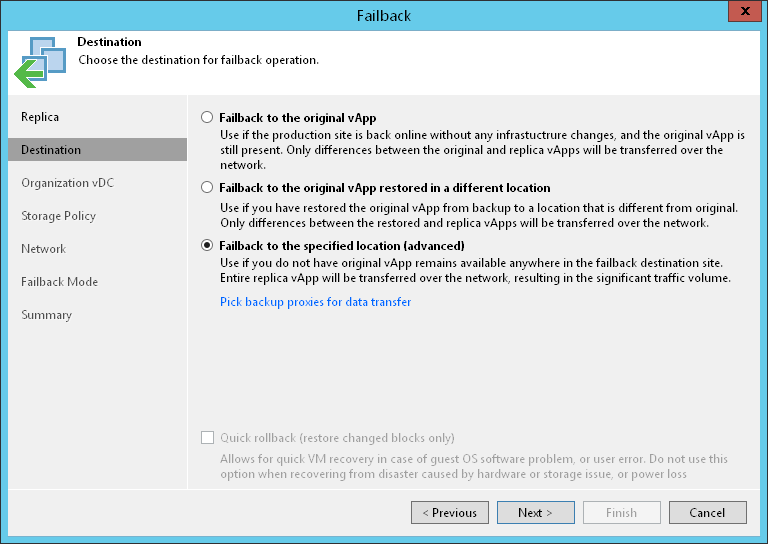 This is an archive version of the document. To get the most up-to-date information, see the current version.
This is an archive version of the document. To get the most up-to-date information, see the current version.Step 3. Select Failback Destination
At the Destination step of the wizard, select the failback destination and backup proxies for vApp data transport during failback.
- Select a destination for failback. Veeam Backup & Replication supports the following options
- Failback to the original vApp — select this option if you want to fail back to the original vApp that resides on the source host. Veeam Backup & Replication will synchronize the state of the original vApp with the current state of its replica and will apply all changes occurred to the vApp replica while it was running in the disaster recovery (DR) site.
If this option is selected, you will proceed to the Failback Mode step of the wizard.
- Failback to the original vApp restored in a different location — select this option if you have recovered the original vApp from a backup in a new location, and you want to switch to it from the replica. Veeam Backup & Replication will synchronize the state of the recovered vApp with the current state of the vApp replica and will apply all changes occurred to the vApp replica while it was running in the disaster recovery (DR) site.
If this option is selected, you will proceed to the Target vApp step of the wizard.
Tip |
You can restore to another vCD. |
- Failback to the specified location — select this option if you want to restore the original vApp from a replica. In this case, Veeam Backup & Replication will recover a vApp to a new location with different settings (such as a vApp location, network settings, storage policy and so on). Select this option if there is no way to fail back to the original vApp or an already recovered vApp.
If this option is selected, you will proceed to the Organization vDC step of the wizard.
Note |
Mind the following:
|
- Click the Pick backup proxies for data transfer link to select backup proxies. Veeam Backup & Replication will use them to transfer data during failback. If vApps and their replica are located in different sites, select at least one backup proxy in the production site and one proxy in the disaster recovery site. If vApps and their replicas are located in the same site, you can use the same backup proxy as the source and target one.
- In the Choose backup Proxy section, click Choose to assign a backup proxy. You can assign backup proxies explicitly or instruct Veeam Backup & Replication to select backup proxies automatically.
- If you choose Automatic selection, Veeam Backup & Replication will detect backup proxies that are connected to the source datastore and will automatically assign optimal proxy resources for processing vApp data.
vApps selected for failback are processed one by one. Before processing a new vApp in the vApp list, Veeam Backup & Replication checks available backup proxies. If more than one backup proxy is available, Veeam Backup & Replication analyzes transport modes that the backup proxies can use, the current workload on the backup proxies to select the most appropriate resource for vApp processing.
- If you choose Use the selected backup proxy servers only, you can explicitly define backup proxies that must be used for data transfer. It is recommended that you select at least two backup proxies to ensure that failover is performed should one of backup proxies fail or lose its connectivity to the source or target datastore.
- [For ESXi hosts prior to version 7.0; for failback to the original vApp] If you want to fasten failback, and the original VMs had problems at the guest OS level, select the Quick rollback check box. Do not use quick rollback if the problem has occurred at the VM hardware level, storage level or due to a power loss. For more information on quick rollback, its requirements and limitations, see Quick Rollback.

Restoring Storage Policies
If the replicated vApp was associated with the storage policy, in the failback to original location scenario, Veeam Backup & Replication will associate the restored vApp with this storage policy.
When you click Next, Veeam Backup & Replication will check storage policies in the virtual environment and compare this information with the information about the replica storage policy. If the original storage policy has been changed or deleted, Veeam Backup & Replication will display a warning. You can select one of the following options:
- Current — the restored VM will be associated with the profile with which the original VM in the production environment is currently associated.
- Default — the restored VM will be associated with the profile that is set as default for the target datastore.
- Stored — the restored VM will be associated with the profile that was assigned to the original VM at the moment of replication.
For more information, see Storage Policy Restore.